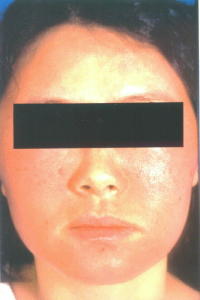This is the commonest skin disorder that can arise from the use of cosmetics. The most frequent presenting complaint is facial itch and rash.
Types of cosmetics causing irritant contact dermatitis include:
- Cleansers: Facial cleansers which often contain surfactants that are necessary to facilitate proper cleansing of the skin.
- Toners and astringents: Toners and astringents may contain alcohol or acids, like alpha-hydroxyacid (AHA). Some patients may develop skin problems from these products.
- Facial treatment: Facial treatment involves the use of manual manipulation and application of chemicals on the skin, often resulting in exfoliation of the upper skin surface. Mild irritation is inevitable, but severe skin inflammation, like dermatitis can occur.
Excessive or inappropriate use of any of these skin care products and procedures can cause skin irritation, especially in individuals with sensitive skin or underlying skin diseases.
What are the symptoms and signs of irritation
Clinical presentation
The patient may experience only burning or stinging sensation after applying the cosmetic on the skin. In severe cases, itchiness, redness, swelling and later scaling and peeling of the skin can occur.

What should I do when I suspect that I have irritation from cosmetics?
Stop using all cosmetic products on the affected skin immediately. Consult your doctor. Do not seek treatment from beauticians or unqualified persons. Your doctor will treat you with a bland facial cleanser and low-potency corticosteroid cream or ointment.
After the rash recovers, patch testing may be required at a later date to exclude allergy to the cosmetics. (See below)
Your doctor will advise you on the appropriate cosmetics to use.